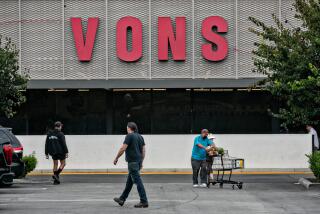Fewer Unhappy Returns
- Share via
Cobra Electronics Vice Chairman Jerry Kalov realized that returns of his company’s products had gotten way out of hand when he stood in Cobra’s Chicago factory holding a battered, 8-year-old cordless phone.
“It was returned to a store because it didn’t work,” said Kalov, who retired as chief executive in January. “And the reason it didn’t work was because some very large dog had used it as a bone.”
Cobra isn’t the only electronics company where return volume has grown to alarming proportions. Consumer electronics returns cost the industry $10 billion in 1997, up from $3 billion in 1990, according to the Consumer Electronics Manufacturers Assn.--thanks in part to liberal return policies. Product defects account for just 2% of returns.
While other businesses also grapple with high returns, it is especially tough on the $72-billion electronics business because profit margins on ubiquitous products like telephones and TVs are so small.
Solving the problem is tricky because the industry doesn’t want to alienate consumers in the process. The industry has already taken steps to reduce returns from consumers who don’t understand how a product works--the No. 1 reason electronics are returned.
Retail chains have improved employee training, for example. And manufacturers have made instruction manuals easier to understand.
But other changes are certain to irk consumers. A number of leading retail chains are tightening their return policies. And a so-called “restocking fee” charged by Circuit City has come under attack by government officials in one state.
How these efforts play out among consumers is especially important during the upcoming holiday season, when the consumer electronics industry reaps about 40% of its yearly sales.
There are several reasons that returns are up, observers say. Because service at superstores is generally inadequate, consumers end up buying gadgets they don’t want. Products have become so complicated that it is often easier to return a VCR or video camera than to figure it out. Generally, consumers are wont to return a product for any reason, from unsatisfactory performance to its being the wrong color.
Electronics companies are finding that in some cases, the solution is an easy fix. For example, Sharp Electronics Corp. put a chip in its VCRs that automatically sets the clock when the machine is plugged in. The company took the step after finding that many consumers who were frustrated with the clock simply returned their VCRs, said Ira Miller, controller for the Japanese company’s U.S. subsidiary.
In other cases, the answer is to improve service so customers leave stores satisfied with their purchases.
Best Buy and Good Guys assign specially trained employees to customer-service counters where they teach shoppers how products work. Good Guys has redesigned many of its stores to include couch-lined service centers to put consumers baffled by technology at ease.
Meanwhile, Casio Inc. is encouraging retail employees to look up product specifications on its Web site, President John McDonald said. The company also sends trainers to stores to coach salespeople.
Efforts to improve training have been hampered by high employee turnover at retail stores. Even so, some companies are finding success. Best Buy says the creation of special “digital products areas” helped double sales of digital cameras and other gizmos in last fiscal quarter. And Casio says its return rate has fallen over the last 18 months to 8.5% from 14%, thanks to its training program and other measures.
At the same time, though, retailers are making it more difficult for dissatisfied shoppers to return products. Many retailers have drastically shortened the period within which consumers may return products to 90 days or even less from one year.
Sam’s Club has imposed a seven-day limit on electronics returns. Its parent, Wal-Mart, has a 15-day return policy for computers. Sears, Roebuck & Co. has revised its 100-year-old policy to require a 60-day return time on computers.
Consumer advocates say companies that impose strict return limits should cut customers some slack.
“Thirty days makes sense, but if someone brings an item back in 45 days they should be able to return it,” said Marti Ann Schwartz, who writes about consumer issues through her Beaverton, Ore.-based company the Consummate Consumer.
And Kalov, who found the chewed phone in his factory while he was CEO of Cobra, says tight return policies appear to be backfiring. Eager to close a sale, retail clerks are encouraging hesitant shoppers to purchase two different makes of the same product, say a VCR, and return the one they don’t like, he said.
The industry’s most controversial measures are aimed at consumers who “borrow” products and bring them back several weeks later. Such returns account for about 12% of the total, according to the Consumer Electronics Manufacturers Assn.
To crack down on such abuses, Best Buy, Circuit City and Comp- USA have initiated restocking fees on products that are returned with the box opened. Best Buy has a 15% restocking fee on digital cameras, camcorders, laptop computers and radar detectors returned after 14 days with the box open.
“This is meant to deter fraud. College students would borrow a laptop computer from us to do a term paper and return it,” said Laurie Bauer, a Best Buy spokeswoman. “We know this because they would return the laptop with the disk with their term paper on it still inside.”
The nation’s largest consumer electronics retailer, Circuit City, instituted a 15% restocking fee on computers in 1997.
“When we considered the thin margins that accompany computer sales and the fact that the product itself changes quickly, we felt we had to protect what little profitability there was in the PC business,” said Morgan Stewart, a spokesman for Circuit City.
But restocking fees met with disapproval from consumer groups and led New York City’s commissioner of consumer affairs to request fines against Circuit City for failing to inform consumers of the fee. Earlier this year, the company was required to mail refund checks to 300 customers who paid the fee. Other retailers have shied away from such charges because of the backlash.
One manufacturer is using technology to crack down on abuses. Seattle-based Nintendo of America devised an electronic registration system after it suffered substantial losses when the introduction of its 16-bit Super Nintendo console prompted consumers to rush to return its eight-bit system, said Peter Junger, a Nintendo vice president.
Retailers who use the system have programmed their registers to prompt employees to enter the serial number of a Nintendo item upon purchase. This information is transmitted to a database at Nintendo.
When a customer returns an item, a clerk can determine when it was purchased, receipt or no receipt, by calling a toll-free number that connects to the database and key in the product’s serial number. The system has reduced return rates at Nintendo by 80% over three years, Junger added.
“This program has worked wonders for Nintendo,” Junger said. “It’s put the problem to rest.”
More to Read
Inside the business of entertainment
The Wide Shot brings you news, analysis and insights on everything from streaming wars to production — and what it all means for the future.
You may occasionally receive promotional content from the Los Angeles Times.










